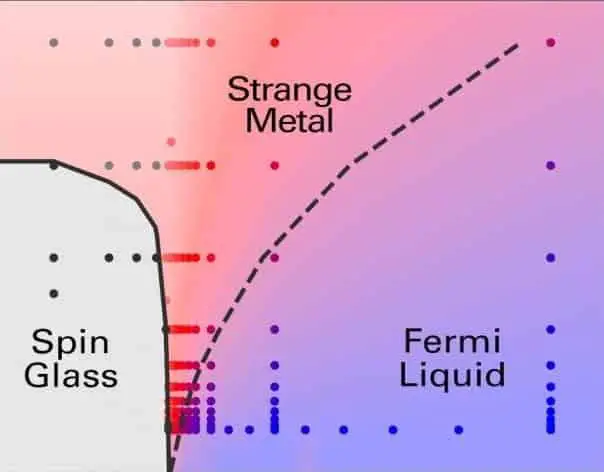Yup. You heard me right. Now, researchers at the Flatiron Institute’s Center for Computational Quantum Physics (CCQ) and Cornell University suggest that strange metals are like a black hole. In their scientific paper, they proposed that strange metals and black holes are somehow related to each other.
This highly critically acclaimed paper was recently published in the Proceedings of the national academy of sciences. The paper titled, “Linear resistivity and Sachdev-Ye-Kitaev (SYK) spin liquid behavior in a quantum critical metal with spin-1/2 fermions” is co-authored by Peter Cha, Oliver Parcollet, Antonie Georges, CCQ associate data scientist Nils Wentzell, and Cornell University Professor Eun-Ah Kim. Here is the list of things I will be discussing in this article.
- What are the strange metals?
- Strange metals and their similarities to high-temperature superconductors
- Similarities between strange metals and black holes
- Solving strange metals model
- New state of matter between Mott insulating spin glasses and Fermi liquids
What Are The Strange Metals?
Well, there was a time when we had only 3 states of matter i.e solid, liquid, and, gas. Now, with time, we have plasma, condensed states of matter, and of course strange metals, etc. Though, their existence has been known for decades. Yet, solving such models with existing methods is impossible to solve.
Finally, for the first time in history, scientists are saying that so-called strange metals could be a freakish new state of matter. Their properties are actually totally the opposite of the conventional normal metals. I mean, if I talk about normal metals, their electrical resistivity is directly proportional to their temperature. On the other hand, strange metal’s electrical conductivity is directly proportional to its temperature.
Editor’s Choice: Astronomers Detect Black Hole and Neutron Star merger: First of its Kind
Strange Metals And Their Relation To High-Temperature Superconductors
Well, for conventional normal metals, electrical resistance increases with temperature, following a complex equation. According to the latest research, when a high-temperature superconductor is heated just above the point where it stops superconducting, the equation becomes much more straightforward. That’s why their electrical conductivity is directly related to their temperature. I mean, maybe strange metals could be key for further understanding of the behavior of High-temperature superconductors.
Similarities Between Strange Metals And Black Holes
Well, on one hand, its electrical conductivity is directly linked with the temperature. On the other hand, it is also linked with the two fundamental constants of the universe i.e Planck’s Constant and Boltzmann Constant. The fact that we call them strange metals should tell you how well we understand them,” says study co-author Olivier Parcollet, a senior research scientist at the Flatiron Institute’s Center for Computational Quantum Physics (CCQ). “They share remarkable properties with black holes, opening exciting new directions for theoretical physics.”
The new work could help physicists better understand the physics of higher-temperature superconductors. Perhaps surprisingly, the work has links to astrophysics. Like strange metals, black holes exhibit properties that depend only on temperature and the Planck and Boltzmann constants, such as the amount of time a black hole ‘rings’ after merging with another black hole. “The fact that you find this same scaling across all these different systems, from Planckian metals to black holes, is fascinating,” Parcollet says.
In case, if you don’t know; as they are directly connected to Planck’s Constant, strange metals are also known as Plankian Metals.
Solving Strange Metals Model
Models of strange metals have existed for decades, but accurately solving such models proved out of reach with existing methods. Quantum entanglements between electrons mean that physicists can’t treat the electrons individually. On the other hand, the sheer number of particles in the material makes the calculations even more daunting.
Cha and his colleagues employed two different methods to crack the problem. First, they used a quantum embedding method based on ideas developed by Georges in the early ’90s. With this method, instead of performing detailed computations across the whole quantum system. Physicists perform detailed calculations on only a few atoms and treat the rest of the system more simply.
They then used a quantum Monte Carlo algorithm which uses random sampling to compute the answer to a problem. The researchers solved the model of strange metals down to absolute zero (minus 273.15 degrees Celsius). The absolute zero is the unreachable lower limit for temperatures in the universe.
New State Of Matter b/w Mott insulating spin glasses and Fermi liquids

The resulting theoretical model reveals the existence of strange metals as a new state of matter bordering two previously known phases of matter: Mott insulating spin glasses and Fermi liquids. “We found there is a whole region in the phase space that is exhibiting a Planckian behavior that belongs to neither of the two phases that we’re transitioning between,” Kim says. “This quantum spin liquid state is not so locked down, but it’s also not completely free. It is a sluggish, soupy, slushy state. It is metallic but reluctantly metallic, and it’s pushing the degree of chaos to the limit of quantum mechanics”.
Conclusion
In my view, my concluding remarks will be that maybe strange metals could be key for further understanding of the behavior of High-temperature superconductors. I mean, there is still a long journey ahead for a better understanding of the properties of High-temperature superconductors.
What do you think? Could we be able to solve the mysteries of high-temperature superconductors with the help of these mind baffling new states of matter? OR MAYBE NOT. Feel free to comment. I am all ears. Sincerely waiting for your thoughtfulness.
Editor’s Choice: Physicists confirm Hawking’s Black Hole Area Theorem; BUT, there is a catch…!!!
Source: Simons Foundation
